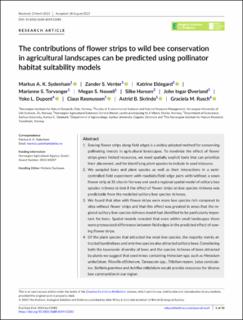| dc.contributor.author | Sydenham, Markus A. K. | |
| dc.contributor.author | Venter, Zander | |
| dc.contributor.author | Eldegard, Katrine | |
| dc.contributor.author | Torvanger, Marianne Strand | |
| dc.contributor.author | Nowell, Megan Sara | |
| dc.contributor.author | Hansen, Silke | |
| dc.contributor.author | Øverland, John Ingar | |
| dc.contributor.author | Dupont, Yoko L. | |
| dc.contributor.author | Rasmussen, Claus | |
| dc.contributor.author | Skrindo, Astrid Brekke | |
| dc.contributor.author | Rusch, Graciela Monica | |
| dc.coverage.spatial | Norway | en_US |
| dc.date.accessioned | 2023-10-10T10:12:41Z | |
| dc.date.available | 2023-10-10T10:12:41Z | |
| dc.date.created | 2023-10-09T09:56:04Z | |
| dc.date.issued | 2023 | |
| dc.identifier.issn | 2688-8319 | |
| dc.identifier.uri | https://hdl.handle.net/11250/3095426 | |
| dc.description.abstract | 1. Sowing flower strips along field edges is a widely adopted method for conserving pollinating insects in agricultural landscapes. To maximize the effect of flower strips given limited resources, we need spatially explicit tools that can prioritize their placement, and for identifying plant species to include in seed mixtures. 2. We sampled bees and plant species as well as their interactions in a semicontrolled field experiment with roadside/field edge pairs with/without a sown flower strip at 31 sites in Norway and used a regional spatial model of solitary bee species richness to test if the effect of flower strips on bee species richness was predictable from the modelled solitary bee species richness. 3. We found that sites with flower strips were more bee species rich compared to sites without flower strips and that this effect was greatest in areas that the regional solitary bee species richness model had identified to be particularly important for bees. Spatial models revealed that even within small landscapes there were pronounced differences between field edges in the predicted effect of sowing flower strips. 4. Of the plant species that attracted the most bee species, the majority mainly attracted bumblebees and only few species also attracted solitary bees. Considering both the taxonomic diversity of bees and the species richness of bees attracted by plants we suggest that seed mixes containing Hieracium spp. such as Hieracium umbellatum, Pilosella officinarum, Taraxacum spp., Trifolium repens, Lotus corniculatus, Stellaria graminea and Achillea millefolium would provide resources for diverse bee communities in our region 5. Spatial prediction models of bee diversity can be used to identify locations where flower strips are likely to have the largest effect and can thereby provide managers with an important tool for prioritizing how funding for agri-environmental schemes such as flower strips should be allocated. Such flower strips should contain plant species that are attractive to both solitary and bumblebees, and do not need to be particularly plant species rich as long as the selected plants complement each other. agri-environmental schemes, bees, flower strips, networks, pollinators, restoration, spatial | en_US |
| dc.language.iso | eng | en_US |
| dc.rights | Navngivelse 4.0 Internasjonal | * |
| dc.rights.uri | http://creativecommons.org/licenses/by/4.0/deed.no | * |
| dc.subject | agri-environmental schemes | en_US |
| dc.subject | bees | en_US |
| dc.subject | flower strips | en_US |
| dc.subject | networks | en_US |
| dc.subject | pollinators | en_US |
| dc.subject | restoration | en_US |
| dc.subject | spatial | en_US |
| dc.title | The contributions of flower strips to wild bee conservation in agricultural landscapes can be predicted using pollinator habitat suitability models | en_US |
| dc.title.alternative | The contributions of flower strips to wild bee conservation in agricultural landscapes can be predicted using pollinator habitat suitability models | en_US |
| dc.type | Peer reviewed | en_US |
| dc.type | Journal article | en_US |
| dc.description.version | publishedVersion | en_US |
| dc.rights.holder | © 2023 The Authors | en_US |
| dc.subject.nsi | VDP::Zoologiske og botaniske fag: 480 | en_US |
| dc.subject.nsi | VDP::Zoology and botany: 480 | en_US |
| dc.source.volume | 4 | en_US |
| dc.source.journal | Ecological Solutions and Evidence | en_US |
| dc.identifier.doi | 10.1002/2688-8319.12283 | |
| dc.identifier.cristin | 2182767 | |
| dc.relation.project | Landbruksdirektoratet: 2021/40207 | en_US |
| dc.source.articlenumber | e12283 | en_US |
| cristin.ispublished | true | |
| cristin.fulltext | original | |
| cristin.qualitycode | 1 | |

